
|

|
|
14th Air Force Scorches Siangtan In 6-Hour Raid HQ., 14th AIR FORCE, May 24 (Special to The China Lantern) - Already disorganized Japanese forces in Central China took a merciless pounding during the week of May 14 through May 20 as Fourteenth Air Force bombers and fighters blasted newly-established supply bases, troop concentrations and shipping on the Hunan and Honan fronts while encountering only one enemy aircraft, a Val bomber, which was shot down. With the Japanese forced to re-route supplies and troops through rearward bases after Paoching, principal funnel for the Chihkiang front was bombed into uselessness as a military installation on May 9, the Fourteenth's striking forces lashed at the new bottleneck, Siangtan, on the Siang river. SIANGTAN SCORCHED Hit by staggered waves of Mitchell bombers in a strike which began at midnight, May 18, and did not end until the city was in flames at daybreak, half of Siangtan was either burned out or blasted out as secondary explosions touched off hidden stores of material intended for use by troops operating against Chihkiang. Throughout the area, fighters and medium bombers flying at tree-top level routed and destroyed enemy troops caught on open highways and in railroad cars, as well as individual units which had been pocketed by pursuing Chinese ground forces and made vulnerable to strafing and fire-bombing. JAP BOMBER DESTROYED The lone Jap Val bomber encountered during the week was intercepted and destroyed by Mustangs operating southwest of Yangchi on the Chihkiang front. While operations in the Honan sector were concentrated against demoralized supply bases and troop reinforcements, after Fourteenth Air Force missions smashed bridges, railroad line and shipping along the Yellow river. In this area, too, fighters and medium bombers destroyed hundreds of enemy troops caught in the open, or in isolated pockets by the low flying strafers and fire-bombers. 1.300 ENEMY TROOPS DESTROYED On the Honan front, between the Han and Yellow rivers, Jap columns which had been driving west from Hsihsiassuchi were forced to withdraw in that city under pressure from ground troops which were supported by the Fourteenth's medium bombers and fighters. Operations on this front also were concentrated against railroad lines, locomotives, rolling stock and bridges. From May 14 through May 16 more than 900 pocketed enemy troops were destroyed and, three days later, 400 of a force of 2,000 were killed by strafing thunderbolts. |
LIQUIDATE 3 OF 5 JAP POCKETS AT CHIHKIANG
HQ., CHINESE COMBAT COMMAND, KUNMING, May 24 - The Japanese offensive toward Chihkiang, which at one time had all the appearances of another triumphed enemy march to another of triumphal enemy march to another of the U.S. Fourteenth Air Force's important bases, this week appeared to have come to an inglorious end in total and ignominious failure.
Although there is always the possibility that the enemy may reinforce his present units in the area and come back for another try, as this week ended it was the Chinese on all sectors of the 80-mile front who were attempting to press forward and close with the enemy. The Japanese, in contrast, were trying just as hard to break-off contact and extricate scattered forces which had been cut off from direct retreat by last week's successful Chinese pincer movement which cut the main Paoching-Chihkiang road many miles to the east of the westward pushing Japanese spearhead at Tungkou.
Of the other two, one, estimated at 1,000 was able to fight its way eastward, cross the Tzui river and thus regain contact with its base at Paoching. The fifth enemy pocket estimated at 2,000 strong, spent all last week fighting its way back from the Tungkou area toward the east, with the probability gradually emerging that it would eventually be able to get out, after heavy casualties.
OFFENSIVE BECOMES RETREAT
Thus, what started as a Japanese offensive to the west on April 4 become a hazardous retreat, with the hills and valley behind the retreating enemy strewn with Japanese corpses and with much valuable enemy material left in Chinese hands. At present, the Chinese have advanced on the main road from a point approximately 60 air miles from Chihkiang to positions well over 100 air miles from that base, thus definitely relieving all imminent threat. On the other hand, Chinese are now only 25 air miles from the Japanese base at Paoching at the closest point of approach.
‘TIGERS’ CONTROL AIR
The net result of almost seven weeks of fighting, as it stands to date, can only be regarded as a morale-inflating Chinese victory and face-losing Japanese defeat, particularly so since this is the first time the Japanese have ventured a major offensive toward an American air base in China without taking it. Sharing the credit for the now apparent victory with the Chinese ground forces were the planes and men of the Fourteenth U.S. Air Force, which had virtually complete control of the air at all times.
|
CHIHKIANG, May 24 (AP) - The stench of mass death clings to the mountain tops and valleys of Western Hunan where the enemy's latest offensive has been shattered and victorious Chinese troops are now engaged in a limited counter-offensive toward Paoching.
The disruption of the Japanese was so complete and precipitate in many places that the enemy abandoned their dead without even token cremation of parts of the bodies, according to their established practice. In some cases no one was left alive in the holdout pockets.
LEAFLETS DROPPED WITH LEAD, BOMBS
The Chinese are in the enviable position of being able to issue "surrender tickets" to large groups of their pocketed foe. Thousands of leaflets, hastily duplicated in the Japanese language, have been dumped by CACW fighter pilots as an off hand duty to be performed on strafing and bombing missions.
The latest word from forward elements of the Chinese divisions indicated that the Japanese are attempting to group for a stand along the eastern side of the Tzul river which was the starting line for their offensive April 10. The greatest potential danger faced by the Chinese attackers was the Japanese reserves which the enemy failed to commit when the offensive first wavered west of the Chihkiang air base.
JAPS WILL FIGHT FOR PAOCHING
It is not likely that the Japanese will yield Paoching without a bitter struggle, since possession of that strategic communications center would open the way eventually for a possible all-out Chinese offensive to slice through the enemy lifeline in the Siang river valley.
Senior officers of the Chinese Combat Command, the American organization at the front helping the Chinese with supply and advising on tactics, are now cast in the role of moderators. The Chinese command is imbued with the idea of a swift, slashing counter-drive while the enemy is still reeling.
LOGISTICS A MAJOR FACTOR
Supply through the western Hunan battle-zone presents a terrific logistical problem which thus far has been adequately answered. It is noteworthy that this has been done without air-dropping, although the Chinese commanders know that as soon as they run dangerously low in rice or ammunition big American transports will be there to parachute it to them.
The Americans are deeply pleased with the counter-offensive spirit of their allies, but anxious not to overstrain the supply system. Evidently, however, the Chinese have convinced them of a limited offensive for Paoching would be worthwhile.
If Paoching can be taken it will be the second American airfield recovered by Chinese arms. The first was Suichwan, which is now occupied in Kiangsi behind Japanese lines.
Paoching fell last year to the Japanese offensive that rolled up the Fourteenth Air Force's central line of bases and their recovery would serve to heighten the air assaults, which before the Chihkiang offensive, had reduced the Japanese movement through the valley to a stealthy nocturnal operation.
|
‘RAIDERS’ BAT 1,000
ON JAPANESE POSITION
HQ., WEST CHINA RAIDERS - An unusual story of front line air cooperation work in the Laohokow area recently was reported by Chinese ground forces.
Several Thunderbolt fighters of the West China Raiders went out to attack an estimated 400 Japanese defending a hill position. The P-47's dropped bombs and sprayed the hill time and again with their machine guns.
Chinese troops, puzzled at the complete lack of resistance, shortly afterward took the hill. They reported 400 dead Japanese.
Chinese Acrobats
Open For Booking
KUNMING - The Chung Hwua acrobatic troupe, which has been enthusiastically received in 16 shows around the various local hostels, are open for further bookings, it was announced by the 14th AF Base Special Service this week.
This famous troupe, formerly with the well-known Ringling Brothers Circus in the United States, are old hands at the business, and their versatile show has been performed both indoors and outdoors where the most primitive stage conditions exist.
They are completely booked for the month of May, it was announced, but their services may be secured for the month of June.
|
|
’Gissimo Adopts American Customs
A 14TH AIR FORCE BASE, CHINA - Generalissimo Chiang Kai-shek recently visited this U.S. Air Base traveling aboard his personal plane, "Mei Ling" named after his best girl - his lovely wife, Soong Mei Ling, better known to Americans as Madame Chiang Kai-shek.
Quite a stir was created when the Generalissimo's plane appeared on the taxiway to pick him up during a recent visit to Maj.-Gen. C. L. Chennault, commanding general, 14th Air Force, and the crowd that had assembled to see him off saw the words "Mei Ling," which the Gissimo had ordered inscribed on the nose of the plane.
The "Mei Ling" is an American built C-47 made available for the Generalissimo's use and flown by a crew of especially picked 14th Air Force men. Piloting the ship is Capt. John S. Papajik, New York City, while the co-pilot is Lt. Leonard J. O'Dell, Charleston, West Virginia.
Picked as navigator for the "Mei Ling" was Lt. William C. Watson, Huntsville, Texas, and completing the crew is Sgt. Ralph D. Yankee, Kansas City, Mo., who acts as engineer and Sgt. John P. Upton, Traverse City, Mich., radio operator.
The Generalissimo had been visiting General Chennault for the purpose of bringing his personal thanks to the officers and men of the 14th Air Force for their most recent efforts in the war in China and to wish them continued success.
16 CBI GIs Back In U.S. For Release
NEW YORK (ANS) - Sixteen veterans of the China-Burma-India Theater were back in the United States this week for discharge under the point system, the first of such a group to be brought back by Air Transport Command planes.
The men arrived at LaGuardia field after flying 57 hours from Karachi, India, via Casablanca. Most of them expected to be back in civilian life within 48 hours.
|
Combined Chinese-American
Staff Expedites War Effort
Chinese and American co-operation in the war effort has been greatly increased by the formation of a Combined Chinese and American Staff, which meets three times weekly in the War Room, United States Forces Headquarters, in Chungking.
First suggested in December, 1944, by Lt. Gen. A. C. Wedemeyer, commanding general of U.S. Forces in China, and United States Chief of Staff to Generalissimo Chiang Kai-shek, the Combined Staff idea has proved a success from the start. Problems that once seemed insuperable because their solation required co-ordinated action by both Chinese and American agencies are frequently resolved in these meetings. New policies may be initiated through recommendation to either the Chinese or Americans commands, but the Staff itself is the machinery for translating orders into action.
Gen. Wedemeyer, when he presides over the meeting, does so in his capacity as United States Chief of Staff to the Generalissimo, rather than as commanding general of U.S. Forces in China. Both Gen. Wedemeyer and Gen. Chen Chung, Chinese Minister of War, try to make it a point to attend one meeting a week. When Gen. Wedemeyer is not present, his place is taken by Brig. Gen. Mervin E. Gross, Holly Hill, S.C., acting chief of staff, U.S. Forces, China Theater.
OPEN DISCUSSIONS ON EVERY SUBJECT
American and Chinese officers representing different staff section of the U.S. Forces and the Chinese Army sit on opposite sides of the T-shaped War Room conference table for open discussions which can cover anything from the organization and disposition of Chinese armies, to the most minute questions of military morale.
While conversation is in both English and Chinese,
|
MEETINGS BRING BETTER UNDERSTANDING
Sitting opposite each other at the conference table and in the even less formal talks held after the meeting, American staff officers and their Chinese counterparts have succeeded in getting to know each other and each other's difficulties. This personal approach to the innumerable small difficulties bound to arise when any attempt is made to co-ordinate the supply, personnel, training, and intelligence policies of two organizations separated by vast differences in methods and outlook, has been a major factor in the successful operation of the Combined Staff.
A typical meeting starts with a short orientation of the world situation by an American officer. The maps and charts with which the War Room is equipped are ideal for this purpose, and all staff members begin their discussion with an up-to-date picture of the war effort as a whole.
Most ordinary questions brought up can be settled at the meeting although more complex problems are submitted in the form of memoranda for further study and recommendation by the staff sections concerned.
CHINESE CUSTOMS OBSERVED
None of the oriental amenities are forgotten. There are two pourings of tea, served Chinese style, during each session, and the name plates set before each officer are in both English and Chinese.
An actual breakdown of the type and number of questions discussed would cover the entire war effort in China. It still would not reflect the total achievement of the Combined Staff, which lies in the friendly co-operation between two Allies which it has served in part to create and which it continues to foster. By allowing close contact between the staffs of the Chinese Army and U.S. Forces in China, it has made it clear that the better acquainted Chinese and Americans become, the more they respect each other and the more they can accomplish.
Co-operation and co-ordination are not just words. In Asia, they are the key to our success. By attaining both to a remarkable degree through their Combined Staff, the soldiers of China and America have come one step closer to victory in the pacific.
|
* * * * * Leader of “Dunning’s Demons” Emerges As One Of The Leading Air Tacticians In China By CLYDE A. FARNSWORTH CHIHKIANG (AP) - Col. John A. Dunning, 31, of San Antonio, Tex., and the United States regular Army has, through the success of aerial intervention on the Chihkiang front, established himself as one of the leading air tacticians in China. For months now he has been commanding the "Little Airforce" on West Hunan front, an assemblage of medium bombers and fighters drawn mostly from Chennault's Chinese-American Composite Wing in which Dunning was a group commander. "THE MOSTEST WITH THE LEASTEST" The strength of Dunning's "Little Airforce" obviously cannot be disclosed but it is worth noting that Chennault's VE Order of the Day made public for the first time that the whole Fourteenth started with less than 70 combat planes. Dunning's tactics undoubtedly helped precipitate the Japanese offensive to knockout the Chihkiang base. The Chinese officer commanding troops there pointed out this fact to the colonel one day when it still was a question of whether the Japanese could hold. "NO - NOT THAT!" A few day later it became apparent that id Dunning's Demons were strong enough to convince the Japanese of the necessity of knocking out of Chihkiang they also were strong enough to set the enemy back on his heels when they tried it. That's what has been done in collaboration with the attack-minded Chinese troops. Dunning's Demons had been smashing at the Japanese corridor through southeastern China in a manner that threatened to choke it completely unless the enemy did something drastic. Before the Chihkiang offensive, supplies over this river-road route from Yangtze to French Indo-China had been reduced to a trickle. BRIDGES DESTROYED METHODICALLY The Siang river was likewise safe only in darkness. In the daytime sampans and other river craft were sitting ducks for Dunning's slugging P-40s and P-51s. Truck traffic for the enemy was reduced to nocturnal operation. Then Dunning and his B-25 pilots worked out night-time intruder tactics against convoys and went out, preferably on moonless nights, when Japanese trucks had to run with lights on, opening themselves to low level bombing and strafing by the mediums. The hazards of such flying along valley roads flanked by mountains cannot be overestimated. It is possible only with consummate daring and thorough knowledge of the terrain. Dunning had also evolved a block system of railway bombing. B-25s systematically covered the railways, section by section, day by day, strewing bombs between rails with Norden bombsights. Railway steel became one of the most critical shortages of the enemy in southeastern China. Railway raiders went out singly, but each with a pair of fighters, not for protection against counterattack by air, for Japanese air force, then as now, is no longer a factor in southeast China but rather to suppress gun positions along the railway. P-40s or P-51s dove in with guns spitting at the first winking flash of Japanese guns. When the Japanese, having massed Paoching fanned out with Chihkiang as their goal, Dunning streamlined his "Little Airforce" into a compact front fighting team to give them a fight such as they never had before in China. CCC ADVISES CHINESE In collaboration with CCC Chinese commanders, the Fourteenth Air Force swiftly placed radio teams on the front, each equipped with transmitter and receiver weighing about 50 pounds, easily transported through rough terrain by pack animal or in a pinch on the back of a soldier. Teams included Chinese interpreters to talk to Dunning's Chinese fliers. Results achieved with radio direction of air attacks were astounding. THOUSANDS OF JAPS KILLED FROM AIR It must be remembered that the Chihkiang campaign was essentially a contest over the security of the Japanese communications corridor through southeast China, the extension of which reaches through southeast Asia to the tip of Malaya. That is the strategic yardstick with which the work of Dunning's Demons must be assessed. The Japanese needed not only a knockout forward base for air assaults on the corridor, but also felt that they must secure a favorable position deep on their flank for the protection of the corridor against an offensive by the resurgent Chinese army along the Chihkiang, Paoching, Hengyang approach. Dunning's CACW command is shared by a Chinese opposite number, that being the system throughout the composite wing, but the tactical direction is left to him. Noteworthy, in conclusion, Dunning is no swivel-chair airman. Recently he flew his 101st fighter mission and he will be around the 110 mark before this dispatch is published. |
|
A campaign to reduce the loss of personnel and equipment due to careless driving by both GI and civilian drivers for the Army, and the promise of strict enforcement of traffic rules by the Military Police, was issued from the office of Lt.-Col. Henry G. Thomas, Wash., D.C., assistant Theater Provost-Marshal, this week.
Emphasizing the fact that 85 percent of the drivers do what is safe, the memorandum, issued to all personnel in the China Theater, was aimed at the other 1`5 percent, who are reckless and drive without consideration for others.
The memorandum pointed out that military traffic on the roads requires caution in meeting and passing Chinese pedestrians, cyclists, and horse and human-drawn vehicles, because many of these persons have poor vision, are deaf or hard of hearing, and their reflex actions are not conditioned to react to fast moving vehicles.
The mixed military and civilian traffic in the cities, complicated by inferior streets and the unfamiliarity of Army personnel with local traffic rules and customs necessitates rigid traffic enforcements by military police and the cooperation of all GI drivers.
In this war of movement over magnitudinal distances, men and material must be moved in an orderly and organized manner so that the advancing troops can arrive where needed without useless casualties. Keeping the roads clear and the traffic moving safely is one of the essentials of accomplishing our tactical and strategic mobility, the memorandum continued.
"Traffic control is dictated by the terrain and the unsatisfactory road networks, which are generally over steep mountains and hills, extremely winding curves, precipitous cliffs and steep grades which are not constructed to withstand heavy traffic. Your truck may have a steel body, but you haven't. Drive Carefully!"
The loss of several trucks here at the end of the line means more than its mere monetary value. The expenditure of the time of the manufacturer, shipper, stevedores, and Ordnance assembly men, in addition to the months necessary to get the vehicles here are the prime considerations.
It is the duty of the GI drivers, not only for their own safety, but for the successful and speedy prosecution of the war, to prevent losses by abiding by the speed and safety regulations, and to keep maintenance repairs down and vehicles off the deadline. "A minute for safety is better than a month for repairs!"
China Pipeline Pushes Ahead
To Fuel Forward Air Bases
HQS., SOS, KUNMING - Rapid progress is being made in pushing the gasoline pipeline to air and transport bases in China, it was indicated in the announcement of the opening here of Advance Headquarters of the Pipeline Section of Advance Section 3, SOS, I-B Theater.
The extension of the pipeline into China was announced jointly recently by Maj.-Gen. G. X. Cheves, commanding general, SOS, China Theater, whose troops handle distribution of gasoline and oil in China, and Maj.-Gen. W. E. R. Covell, formerly commanding general, SOS. I-B Theater, whose Engineer Petroleum Distributing Companies, with aid of Chinese labor, are pushing the fuel line eastwards.
Maj. Charles L. Reasoner, native of Colorado Springs, Colo., whose home is now in California, commands the new advance headquarters and Maj. E. B. Bailey, Tacoma, Wash., is executive officer.
The Advance Headquarters has been a floating organization with brief stations at several locations along the Stilwell Road since leaving the main headquarters at Ledo in Assam. Four of the Engineer Petroleum Distributing Companies with all equipment were flown over the "Hump" to push the work in China. Jeeps and trucks of this pipeline outfit carry an insignia which is a horseshow turned up to hold a full measure of good luck mounted against a spot of gold color.
Engineers at the headquarters here say that the pipeline thus far is about 200 miles shorter than the Stilwell Road because many of the road kinks have been straightened out. Access roads were built to get pipeline materials to inaccessible areas. Chinese laborers in some places carried the pipe lengths as far as 11 miles from the main highway.
Chinese and American cooperation has been outstanding on the pipeline according to Mr. Chu Kuo-shi, a director of the Chinese Pipeline Engineering Administration. Most of the material for the line has been supplied by American forces and much has been flown in over the Himalaya Mountains.
Chinese have done the surveying while Americans have laid general plans for the route. Americans have furnished motor transport and in some localities Chinese have provided rail transportation.
Each of the Chinese construction teams has included six or eight Chinese engineers, ten or more foremen, and 500 to 1,000 laborers.
Most of the technical work of installing pumping stations, connecting pipe and construction of storage facilities has been supervised by U.S. Army personnel.
Planning and working has been so coordinated that the first flow of gasoline into an airbase in China was six days ahead of schedule, it was reported.
Virtually all of the personnel associated with the pipeline forces are men with broad experience in refinery and pipeline operations in the United States. They have been with the pipeline construction wok all the way from ports in India up through the mountains into China.
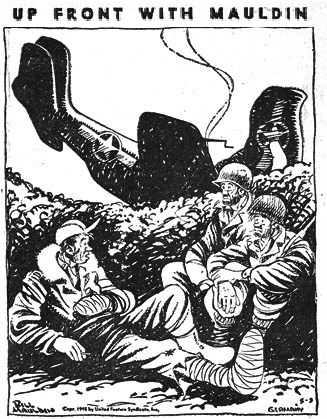
|
ATC I-C Division Records
Set By China Wing In April
1350TH BU, CHINA - China Wing Air Transport Command bases topped all previous cargo and passenger service records during the month of April to add new laurels to their already impressive record, it was announced by Col. Richard F. Bromiley, wing commander.
The China Wing had the lowest accident rate in the division during April and bettered its own past records according to Maj. Irving Hurwitz, head of the statistical control section.
Greater emphasis on improved engineering methods kept more China Wing aircraft in commission, bettering the March record. Maximum flying time from every plane, also made forward strides. Aircraft averaged 7.1 hours per day, an increase of 4.4 over the March figure. The 1343rd base unit flew away with the honors among China fields by keeping its planes in the air well over 7 hours per day, with the 1339th BU taking second honors in this department.
Turnaround time was improved at every base in the China Wing. Using an average of all previous turnaround figures, stat control estimated that the China Wing saved several thousand hours. This means that planes arriving from India were kept on the ground for shorter unloading periods, resulting in more time for the return trip and the picking up other loads. It is estimated that an additional 1,500 tons of cargo are flown over the "rock pile" because of this saving in time.
Pleased with the April showing, which reflects credit upon his entire command, Col. Bromiley believes the China Wing is on the way to new highs. "We're going to do our best to beat last month's figures, and there's no reason why we can't if every man does his job," he said. "We want a perfect score on accidents and aircraft utilization can be brought up considerably."
|
“Pipers” Leader Gets Commission
CHINESE COMBAT COMMAND - John W. Parker, 24-year-old staff sergeant from Madison, Wis., author of "I Want A G-I Mama," received a direct commission as second lieutenant. Remembered by hundreds of American servicemen in India as leader of the "Swing Patrol," the musical aggregation which traveled with Maj. Melvyn Douglas,

|
Parker helped bring musical entertainment to servicemen in India and Burma from July, 1942, until February, 1943, when he was flown across the Himalayan "Hump" to China, where his "Pinky Pipers" played to GIs during the Chinese Expeditionary Force's successful Salween campaign.
The newly commissioned lieutenant, was ordered to the U.S. in December, 1944, to attend the Army Information-Education School. He returned to China in March, 1945, and is now serving as a Special Service officer with a headquarters of the Chinese Combat Command near Kunming, in addition to directing "The Pipers."
AVG History Related To Kwei Chu Hui
KUNMING - Many interesting sidelights on the early history of the American Volunteer Group which gave the Japs their first taste of keen opposition in the air over China were given by Col. Thomas C. Gentry, of Dallas, Texas, surgeon of the 14th Air Force, at the Kwei Chu Hui recently.
The Masonic Club, composed of officers in the U.S. and Chinese Forces who are Master Masons, had dinner at the Red Cross Town Club and met later at Hostel 14. The colonel recounted an air raid of December 18, 1941 which did a lot of damage not far from the meeting place. But next day when the Jap bombers came they met tough opposition. The AVG battled them in many other places.
Their leader, now Maj.-Gen. C. L. Chennault, who commands the 14th Air Force, is honorary president of the club.
It was voted that the club will meet on the first even-dated Monday in each month. Next meeting will be June 4. Nominations for a new group of officers will be presented. Col. Archibald D. Fiskin is the retiring president.
|
AIR MEDAL TO PILOT FOR SAVING LEADER
AN EAST CHINA WING, 14TH AIR FORCE BASE - For guiding his nearly blinded formation leader back to a safe landing by radio, Lt. John F. Egan, Fort Lauderdale, Fla., has been awarded the Air Medal by Maj.-Gen. C. L. Chennault, commanding general, 14th Air Force.
"On 26 December 1944," the citation reads, "he participated in a skip-bombing attack on enemy shipping during which his formation leader (Maj. John E. Meyers, Birmingham, Ala.) was partially blinded by a burst of flak and called for help.
"Lt. Egan left the target and skillfully led the nearly blinded pilot back to his base, bring him in for a safe landing by flying his own plane in front and directing the other's landing procedure by radio. The disregard for personal safety and brilliant flying by Lt. Egan reflects great credit upon himself and the AAF.'
Egan had previously received the Distinguished Flying Cross for another mission with Maj. Meyer in which "They distinguished themselves as pilots of fighter type aircraft when they participated in a two-plane attack against a 500-foot transport vessel in a heavily defended harbor in enemy-held China.
‘Bulldogs’ Open New Enlisted Men’s Club
To the music of a six-piece swing band led by Sgt. Art "Rosia" Rosenberg, Milwaukee, Wis., the enlisted men of the "Bombing Bulldogs" crowded their elaborate new club for its gala opening early this month.
The new club is the culmination of nearly two months work, and lays claim to being one of the best of its kind in the theater. Furnished with comfortable, leather-upholstered lounges and chairs obtained through Special Service, the main theme of decoration is carried out in split and woven bamboo from local sources. On the walls and behind the bar are the leggy 'Petty' girls painted by Corp. Larry Klein, Newark, N.J.
Available to the weary GIs after a hard day's work will be a selection of cool drinks, eggs, "buffalo-burgers" and any other delicacies that may be on hand at the time. The club will be open four nights a week.
Working along with S/Sgt. George Alderman, Miami, Fla., president of the club, were S/Sgt. William Sedlak, Perth Amboy, N.J., Corp. George Hendrick, Kennet Square, Pa., and Corp. Edward Robinson, Shreveport, La. 1st/Sgt. Ernest A. Koury, Burlington, N.C., did much of the planning and paper work necessary for the completion of the club.
|
After 131,280 Air Miles, 101
Bomb Drops, 'Hazel' Retires
A FOURTEENTH AIR BASE, CHINA - Hustlen Hazel, the namesake of a beautiful Chinese girl and a twin-engined bomber of the famous fighting Jiggs Squadron, has been retired from active combat duty.
With approximately 131,280 air miles flown on her original engines - total of 483 hours and 20 minutes, ole Hustlen Hazel, as she is affectionately referred to by members of the air crews and ground personnel, has flown her last combat mission in the China Theater.
With a record of 101 bomb drops, this medium bomber has flown on every type of mission against Japanese installations in occupied China, Burma and French Indo-China. Low levels, high levels, night missions, bridge-busting, sea sweeps and food dropping to isolated Chinese troops all were in a part of Hazel's campaign against the Japs.
During her long and gallant combat career, Hustlen Hazel was sometimes called the lucky ship as the enemy was able to leave their mark on her on few occasions. While operating in a valley near Kweilin, Hazel was hit by explosive 20mm shells in her left wing, ripping a wide hole near the nacelle.
Also on this mission, two bursts of 7.7 rifle fire damaged her left engine. After landing at her home strip, S/Sgt. Leroy E. Sloan, Shawnee, Oklahoma, her crew chief, had her well patched and back in the air within a few hours.
Sloan has been crew chief of Hustlen Hazel since September 1944. Assisting Sgt. Sloan in his duties is Sgt. Robert J. Ehmke, Milwaukee, Wis. Both Sgts. Sloan and Ehmke have been members of the famous Jiggs squadron since coming overseas.
ONE ‘OBJECTIVE BURMA’ SCENE DRAWS CHEERS
AN ADVANCE CHINA BASE, 14TH AF - It was during the tense and dramatic scene of the paratroop raid on the Japanese radar station in the motion picture "Objective, Burma" when a member of the "Liberators of China" group set off a howl of approval.
The Hollywood GIs had killed off all visible resistance at the station. In the course of mopping up, three troopers disappeared into the Jap mess hall. Staccato noise of machine gun fire was heard. The audience tense and quiet was aroused when someone exclaimed, "They got the Mess Sergeant."

|
|
The CHINA LANTERN is the newspaper for the United States Forces in the China Theatre and is published three times weekly by Lt. Lester H. Geiss, Editor-in-Chief, for military personnel only. Lt. Harry D. Purcell, Managing Editor; Lt. Maurice Pernod, Production Chief. Pfc. Richard P. Wilson, Reporter. Editorial offices: Hqrs., SOS China Theater, Kunming, China, and Hqrs., SOS, Calcutta, India. Printed by Ajit Kumar Sinha at the "Amrita Bazar Patrika" Press, Calcutta. Unless specifically stated, news and features appearing in the China Lantern do not necessarily represent the views of the War Department; the Commanding General, USF, CT, or any other official source.

MAY 25, 1945
Adapted from the original issue of The China Lantern
Copyright © 2019 Carl Warren Weidenburner
TOP OF PAGE PRINT THIS PAGE ABOUT THIS PAGE
SEND COMMENTS CLOSE THIS WINDOW
 CARRIER USS FRANKLIN ABLAZE in the Pacific, left, after she was struck by Japanese dive-bombers during the American strike on the
Japanese island of Kyushu in Japan's inland sea.
The Franklin's crew and men of the cruiser USS Santa Fe succeeded in conquering the fire.
Right, listing badly, the Franklin proceeds under her own power at the start of the 12,000 mile voyage to New York.
The 20,000-ton carrier arrived home for repairs and will soon sail to fight again. - (Radiophotos.)
CARRIER USS FRANKLIN ABLAZE in the Pacific, left, after she was struck by Japanese dive-bombers during the American strike on the
Japanese island of Kyushu in Japan's inland sea.
The Franklin's crew and men of the cruiser USS Santa Fe succeeded in conquering the fire.
Right, listing badly, the Franklin proceeds under her own power at the start of the 12,000 mile voyage to New York.
The 20,000-ton carrier arrived home for repairs and will soon sail to fight again. - (Radiophotos.)
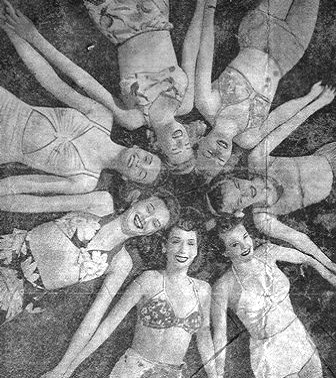 TWINKLING STARLETS - Smiling at their chance to be groomed at stars of tomorrow, these girls are all under contract to Republic as dancers.
They'll appear in the musical "Mexicana." Starting with the girl wearing the ribbon in her hair and reading left, counter-clockwise, they are
Marian Kerrigan, Harriett Dadon, Beverly Reedy, Melva Andstead, Geraldine Farnum, Dorothy Stevens and Frances Gladwin.
TWINKLING STARLETS - Smiling at their chance to be groomed at stars of tomorrow, these girls are all under contract to Republic as dancers.
They'll appear in the musical "Mexicana." Starting with the girl wearing the ribbon in her hair and reading left, counter-clockwise, they are
Marian Kerrigan, Harriett Dadon, Beverly Reedy, Melva Andstead, Geraldine Farnum, Dorothy Stevens and Frances Gladwin.
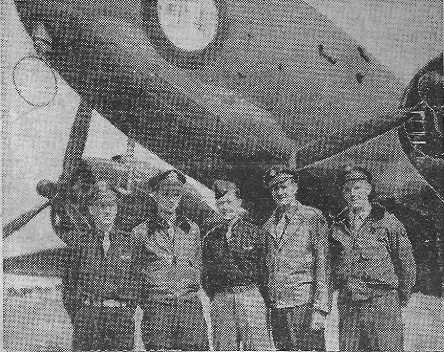 THE GENERALISSIMO'S CREW, members of the Fourteenth Air Force, beneath the nose of "Mei Ling," left to right, Capt. John S. Papajik,
New York City, pilot; Lt. William C. Watson, Huntsville, Texas, navigator; Lt. Leonard J. O'Dell, Charleston, W.Va., co-pilot; Sgt. Ralph
D. Yankee, Kansas City, Mo., engineer, and Sgt. John P. Upton, Traverse City, Mich., radio operator. (Air Forces photo).
THE GENERALISSIMO'S CREW, members of the Fourteenth Air Force, beneath the nose of "Mei Ling," left to right, Capt. John S. Papajik,
New York City, pilot; Lt. William C. Watson, Huntsville, Texas, navigator; Lt. Leonard J. O'Dell, Charleston, W.Va., co-pilot; Sgt. Ralph
D. Yankee, Kansas City, Mo., engineer, and Sgt. John P. Upton, Traverse City, Mich., radio operator. (Air Forces photo).
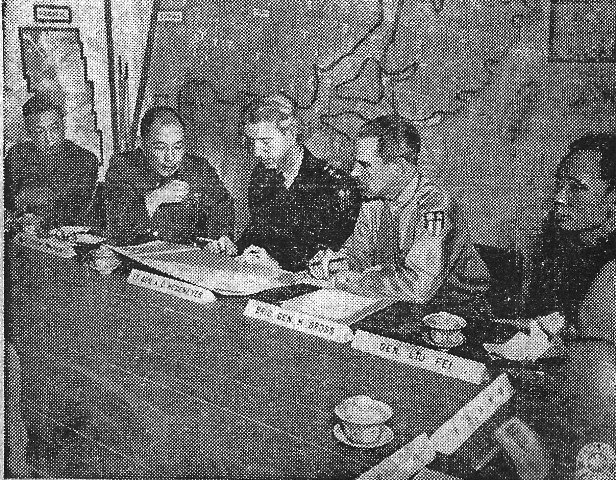 OPERATIONS IN THE CHINA THEATER have been co-ordinated through the Combined Chinese-American Staff which meets regularly in the War Room,
Headquarters, United States Forces, in Chungking. Among Oriental customs observed by American Staff officers is the serving of tea, and Chinese
style cups fitted with covers to keep the tea leaves in the cup can be seen on the table. Lt.-Gen. A. C. Wedemeyer, Omaha, Neb., commanding general,
United States Forces, China Theater, and United States Chief of Staff to Generalissimo Chiang Kai-shek, presides over the staff meetings. Left to right,
Gen. Chu Shih-ming, former Military Attache in Washington; Gen. Chien Ta-chun, personal chief of staff to the Generalissimo; Gen. Wedemeyer;
Brig.-Gen. Mervin E. Gross, Holy Hill, S.C., acting chief of staff, United States Forces; and General Liu Fei, vice-minister of the Ministry of
Military Operations. (Signal Corps photo).
OPERATIONS IN THE CHINA THEATER have been co-ordinated through the Combined Chinese-American Staff which meets regularly in the War Room,
Headquarters, United States Forces, in Chungking. Among Oriental customs observed by American Staff officers is the serving of tea, and Chinese
style cups fitted with covers to keep the tea leaves in the cup can be seen on the table. Lt.-Gen. A. C. Wedemeyer, Omaha, Neb., commanding general,
United States Forces, China Theater, and United States Chief of Staff to Generalissimo Chiang Kai-shek, presides over the staff meetings. Left to right,
Gen. Chu Shih-ming, former Military Attache in Washington; Gen. Chien Ta-chun, personal chief of staff to the Generalissimo; Gen. Wedemeyer;
Brig.-Gen. Mervin E. Gross, Holy Hill, S.C., acting chief of staff, United States Forces; and General Liu Fei, vice-minister of the Ministry of
Military Operations. (Signal Corps photo).
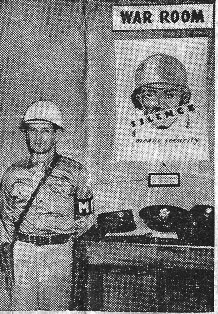 ON GUARD at the door of the War Room at Headquarters, United States Forces, China Theater, in Chungking, during a meeting of the Chinese and
American Combined Staff, is M.P. Corp. Robert B. Hill of Elmira, N.Y. Chinese and American caps on the table serve to illustrate the close co-operation
between American and Chinese forces that regular meetings of the Combined Staff at American Headquarters in Chungking have made possible. (Signal Corp photo).
ON GUARD at the door of the War Room at Headquarters, United States Forces, China Theater, in Chungking, during a meeting of the Chinese and
American Combined Staff, is M.P. Corp. Robert B. Hill of Elmira, N.Y. Chinese and American caps on the table serve to illustrate the close co-operation
between American and Chinese forces that regular meetings of the Combined Staff at American Headquarters in Chungking have made possible. (Signal Corp photo).
 A U.S. ARMY MEDICAL OFFICER, Maj. R. T. Shields, Winchester, Va., treats an injured Chinese soldier, the victim of a truck accident.
A U.S. ARMY MEDICAL OFFICER, Maj. R. T. Shields, Winchester, Va., treats an injured Chinese soldier, the victim of a truck accident.
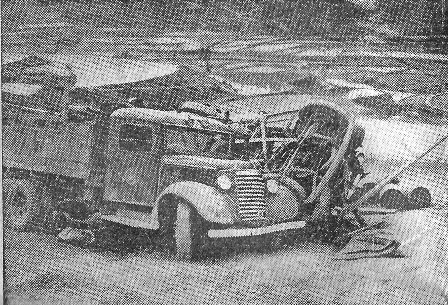 FOUR CASUALTIES resulted from this accident which involved four Chinese trucks, two of which are shown in the above picture.
FOUR CASUALTIES resulted from this accident which involved four Chinese trucks, two of which are shown in the above picture.
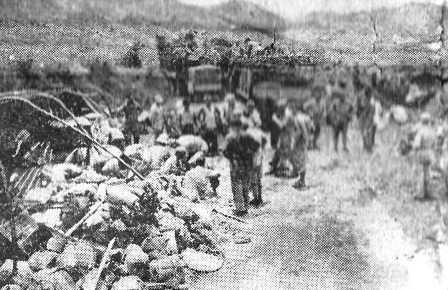 LOADED WITH RICE, cooking utensils and Chinese soldiers, this 6x6 overturned in an accident near the Tai Lee Shu mountains while engaged
in evacuation work in the Kweilin area last summer.
LOADED WITH RICE, cooking utensils and Chinese soldiers, this 6x6 overturned in an accident near the Tai Lee Shu mountains while engaged
in evacuation work in the Kweilin area last summer.
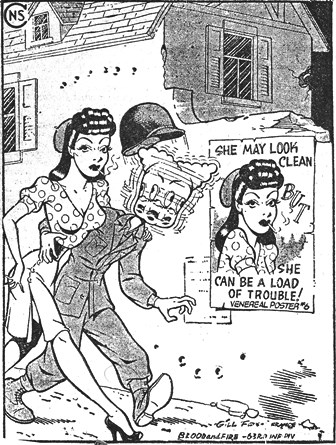
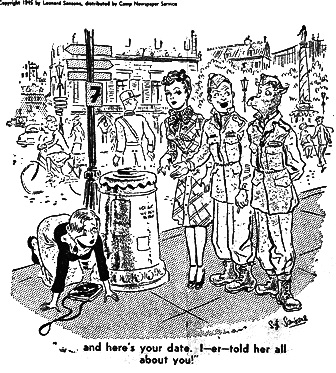
 HUSTLEN HAZEL, HERSELF, and S/Sgt. Leroy E. Sloan, Shawnee, Okla., crew chief of the ship since September 1944.
A record of the colorful and adventurous combat career of the retired Jiggs Squadron twin-engined bomber is plainly visible for all to see.
HUSTLEN HAZEL, HERSELF, and S/Sgt. Leroy E. Sloan, Shawnee, Okla., crew chief of the ship since September 1944.
A record of the colorful and adventurous combat career of the retired Jiggs Squadron twin-engined bomber is plainly visible for all to see.
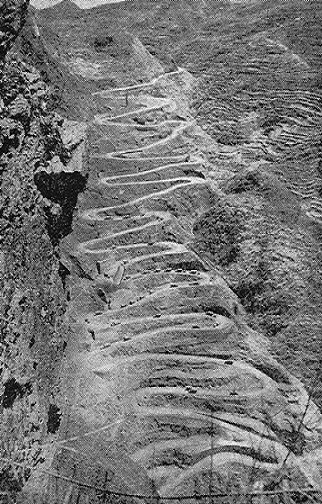 TWENTY-ONE CURVES in one of the most fantastic stretches of road in the world, being navigated by a China Theater SOS convoy as it moves up
the mountain side. This road is now undergoing repairs and improvements with the Burma Road Engineers assisting the Chinese highway organization.
TWENTY-ONE CURVES in one of the most fantastic stretches of road in the world, being navigated by a China Theater SOS convoy as it moves up
the mountain side. This road is now undergoing repairs and improvements with the Burma Road Engineers assisting the Chinese highway organization.
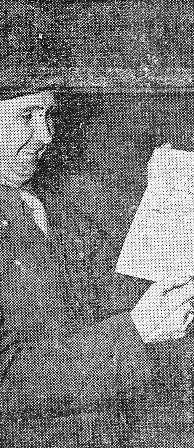 FIRST SOLDIER to be discharged from Army at Fort Dix, Pfc. John Culhans of New York, reads his honorable discharge papers.
The 30-year-old veteran of African, Italian and French campaigns, is first of 1,200 to be discharged from the camp.
FIRST SOLDIER to be discharged from Army at Fort Dix, Pfc. John Culhans of New York, reads his honorable discharge papers.
The 30-year-old veteran of African, Italian and French campaigns, is first of 1,200 to be discharged from the camp.
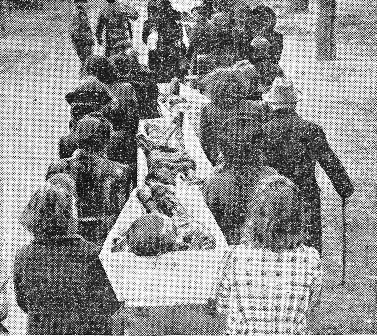 UNWILLING pallbearers carry coffins from the woods where 101 Polish Jews were shot by SS troops in Nuremberg to a cemetery a mile away.
German civilians were forced by U.S. military authorities to perform the unpleasant task.
UNWILLING pallbearers carry coffins from the woods where 101 Polish Jews were shot by SS troops in Nuremberg to a cemetery a mile away.
German civilians were forced by U.S. military authorities to perform the unpleasant task.
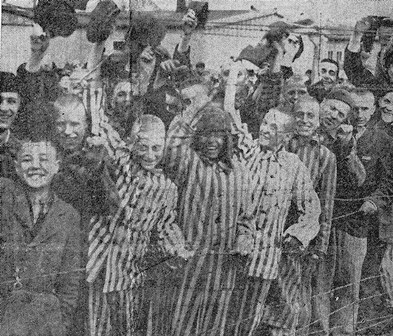 YANKS CAME IN TIME - Survivors of horrors at Dachau line electric fence to welcome 42nd Rainbow Division that liberated them.
Those in striped suits were destined for crematorium.
YANKS CAME IN TIME - Survivors of horrors at Dachau line electric fence to welcome 42nd Rainbow Division that liberated them.
Those in striped suits were destined for crematorium.
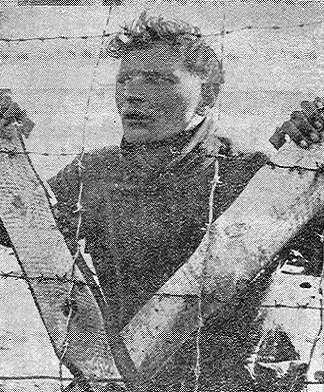 NAZI WEREWOLF looks menacingly through V-shaped boards of barbed wire fence in Germany.
Werewolf units were hastily formed to carry out guerrilla warfare behind Allied lines when situation became hopeless for Germany.
NAZI WEREWOLF looks menacingly through V-shaped boards of barbed wire fence in Germany.
Werewolf units were hastily formed to carry out guerrilla warfare behind Allied lines when situation became hopeless for Germany.